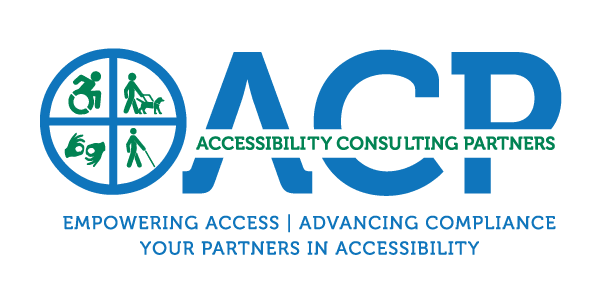Planning ADA‑Compliant Events, Meetings, and Public Engagement Sessions
At Accessibility Consulting Partners (ACP), we believe public meetings should welcome everyone. When you prioritize access and inclusion, you build stronger connections, credibility, and community trust.
Why Accessible Events Matter

- Everyone can participate. From people with mobility limitations to sensory or cognitive differences, inclusive meetings ensure diverse voices contribute meaningfully.
- You meet legal obligations. Title II of the ADA requires public entities to remove access barriers and provide reasonable accommodations.
- You build trust. Accessible planning sends the message that you value all perspectives.
How to Plan with Access in Mind
1. Choose the Right Venue
- Confirm that entrances, restrooms, parking, and pathways comply with ADA standards.
- Avoid temporary ramps with steep slopes. Instead, use built-in accessible entries whenever possible.
- Check signage contrast and visibility. People with visual impairments need simple, readable wayfinding.
2. Think About Sensory Access
- Provide assistive listening devices and real-time captioning for in-person events.
- Offer livestream or recording options with captions and transcripts.
- Design quiet zones or sensory-friendly spaces for attendees who need visual breaks or reduced stimuli.
3. Use Plain Language and Clear Materials
- Keep presentations easy to follow—limit jargon and use short sentences.
- Distribute agendas and handouts in advance, in accessible formats (like PDF with tagged headings).
- Use large fonts, strong color contrast, and meaningful headings for better readability.
4. Promote Inclusion in Engagement
- Plan multiple ways to participate: live Q&A, chat functions, mailed in questions, or accessible online forms.
- Offer alternate formats like ASL interpreters or translation services if needed.
- Train staff and moderators to recognize and support access needs—then test systems in advance.
5. Communicate Accommodations Up Front
- In your event notices, include a clear statement:
“We welcome accessibility requests. Please contact us by [date] to arrange accommodations.” - Make all communication channels accessible: email, phone, website (WCAG-compliant), and physical mail.
- Confirm requests early and send reminders to attendees about access supports being provided.
Real Impact: What Inclusion Feels Like
Imagine a resident relying on a wheelchair who arrives only to find the venue doesn’t offer an accessible entrance. Now compare that to an attendee who finds clear accessible signage, friendly staff, live captioning, and a space designed for sensory comfort. The latter scenario reflects the experience ACP strives to support.
Quick-Start Checklist
| ✅ Action | Why It Matters |
|---|---|
| Confirm venue accessibility | Ensures physical access barriers are removed |
| Request accessibility needs with RSVP | Allows for planning ahead |
| Offer multiple participation methods | Grows inclusive engagement |
| Provide supports like captioning & interpreter services | Improves understanding and equity |
| Train staff on access etiquette | Creates smoother, more respectful interactions |
Wrap-Up: Design With People First
At ACP, we know how access empowers inclusion—and how thoughtful planning strengthens trust and credibility. When you design events that prioritize all abilities, you ensure everyone can take part, engage, and feel valued.
Ready to plan an accessible public meeting? We’re here to help design an inclusive experience that truly reflects your community.
